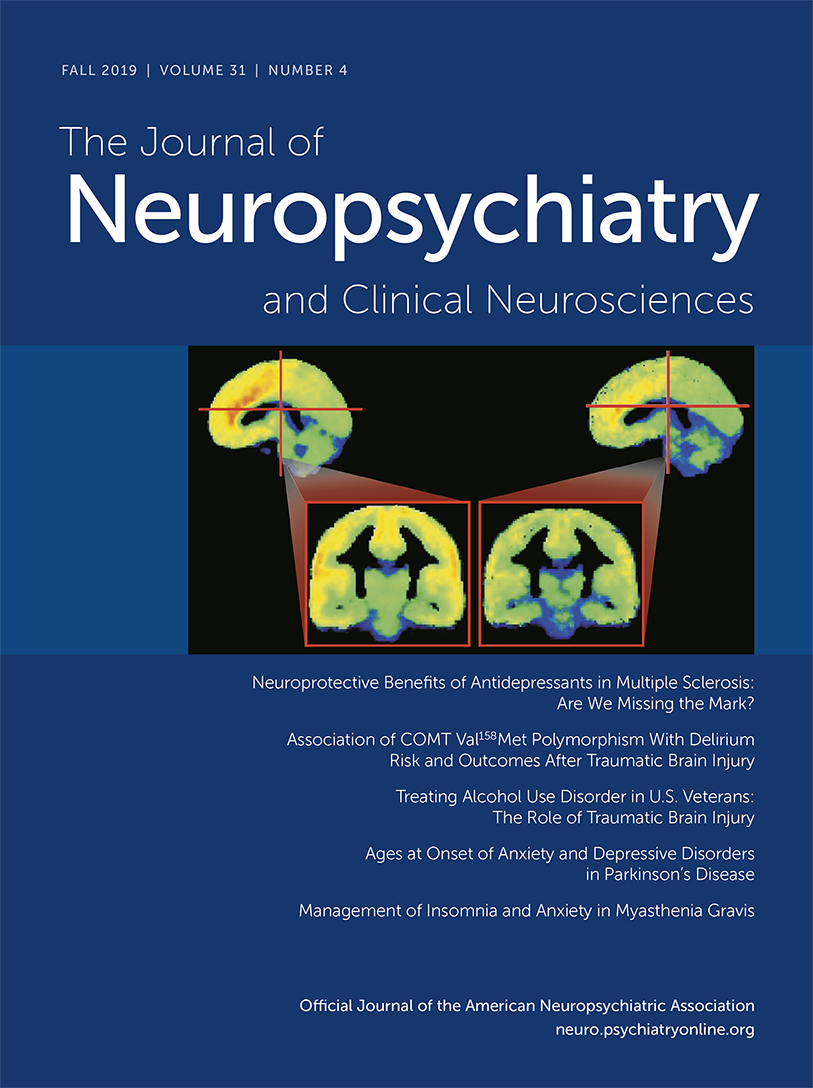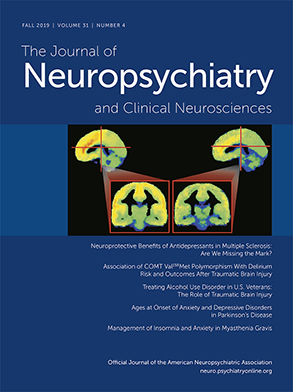Cognitive Impairment and Predicting Response to Treatment in an Intensive Clinical Program for Post-9/11 Veterans With Posttraumatic Stress Disorder
Abstract
Objective:
Methods:
Results:
Conclusions:
Methods
Participants
| Characteristic | M or N | SD or % |
|---|---|---|
| Age (years) (M±SD) | 39.7 | 8.5 |
| Gender | ||
| Female | 22 | 19.5 |
| Male | 91 | 80.5 |
| Race | ||
| White | 87 | 77.0 |
| Black or African American | 14 | 12.4 |
| Asian | 1 | 0.9 |
| American Indian or Alaska Native | 1 | 0.9 |
| Other | 9 | 8.0 |
| No response | 1 | 0.9 |
| Ethnicity | ||
| Hispanic or Latino | 11 | 9.7 |
| Not Hispanic or Latino | 102 | 90.3 |
| Relationship status | ||
| Partnered | 73 | 64.6 |
| Single | 40 | 35.4 |
| Education (years) (M±SD) | 14.5 | 2.1 |
Measures
PCL-5.
Patient Health Quesionnaire-9 (PHQ-9).
Self-Efficacy for Symptom Management Scale (SE-SMS).
Patient-Reported Outcomes Measurement Information System–Satisfaction With Participation in Social Roles and Activities–Short Form 8a (version 1.0) (PROMIS-S).
CNS Vital Signs.
Assessment Procedures and Treatment Program
Analyses
Results
| Not impaired (N=57) | Impaired (N=56)a | ||||||
|---|---|---|---|---|---|---|---|
| Characteristic | M or N | SD or % | M or N | SD or % | Statistic (χ2 or t)b | p | Cohen’s d |
| Age (years) (M±SD) | 39.0 | 8.3 | 40.3 | 8.8 | –0.78 | 0.43 | 0.15 |
| Gender | |||||||
| Male | 41 | 45.1 | 50 | 55.0 | 5.43 | 0.02 | — |
| Female | 16 | 72.7 | 6 | 27.3 | |||
| Education (years) (M±SD) | 15.1 | 2.1 | 13.8 | 1.8 | 3.61 | <0.001 | 0.66 |
| Relationship status | |||||||
| Partnered | 30 | 41.1 | 43 | 58.9 | 7.21 | 0.007 | — |
| Single | 27 | 67.5 | 13 | 32.5 | |||
| Measure | 1 | 2 | 3 | 4 | 5 | 6 | 7 | 8 | 9 |
|---|---|---|---|---|---|---|---|---|---|
| 1. Δ PCL-5 | — | ||||||||
| 2. Δ PHQ-9 | 0.62** | — | |||||||
| 3. Δ Self-efficacy | –0.23* | –0.10 | — | ||||||
| 4. Δ PROMIS-S | –0.46** | –0.31** | 0.16 | — | |||||
| 5. Verbal memory standard score | 0.06 | 0.00 | 0.01 | 0.03 | — | ||||
| 6. Visual memory standard score | 0.05 | 0.00 | 0.06 | –0.10 | 0.61** | — | |||
| 7. Executive functioning standard score | –0.04 | 0.03 | –0.12 | 0.01 | 0.44** | 0.44** | — | ||
| 8. Processing speed standard score | –0.02 | –0.04 | 0.12 | 0.10 | 0.52** | 0.40** | 0.57** | — | |
| 9. Reaction time standard score | 0.10 | –0.08 | –0.08 | 0.01 | 0.40** | 0.39** | 0.45** | 0.47** | — |
| 10. Neurocognitive Index standard score | 0.04 | 0.02 | –0.14 | –0.01 | 0.63** | 0.59** | 0.78** | 0.50** | 0.62** |
| Measure and group | Time | Mean | SD | Median | Interquartile range |
|---|---|---|---|---|---|
| Traumatic stress, PCL-5 | |||||
| Not impaired | |||||
| Pretreatment | 52.6 | 11.4 | 50 | 44–62 | |
| Posttreatment | 37.1 | 14.1 | 37 | 25–48 | |
| Impaired | |||||
| Pretreatment | 55.4 | 12.6 | 57 | 48–64 | |
| Posttreatment | 37.9 | 16.7 | 36 | 27–46 | |
| Depression, PHQ-9 | |||||
| Not impaired | |||||
| Pretreatment | 16.1 | 5.3 | 16 | 11–20 | |
| Posttreatment | 10.5 | 4.7 | 9 | 7–14 | |
| Impaired | |||||
| Pretreatment | 16.4 | 5.2 | 15.5 | 13–20 | |
| Posttreatment | 11.7 | 6.0 | 10.5 | 8–15.5 | |
| Self-efficacy, SE-SMS | |||||
| Not impaired | |||||
| Pretreatment | 16.4 | 7.6 | 16 | 12–20 | |
| Posttreatment | 21.3 | 7.7 | 20 | 16–28 | |
| Impaired | |||||
| Pretreatment | 14.8 | 7.3 | 14 | 8.5–20 | |
| Posttreatment | 20.7 | 7.8 | 20 | 16–25 | |
| Satisfaction with social roles, PROMIS-S | |||||
| Not impaired | |||||
| Pretreatment | 40.1 | 7.0 | 39.9 | 36.7–44.3 | |
| Posttreatment | 45.7 | 7.5 | 44.7 | 41.4–49.1 | |
| Impaired | |||||
| Pretreatment | 36.1 | 6.5 | 38.8 | 26.9–41.0 | |
| Posttreatment | 42.6 | 9.7 | 42.2 | 36.9–45.6 |
| Test and variable | Measure | F | df | p | Effect size (ηp2) |
|---|---|---|---|---|---|
| Multivariate (within subjects) | |||||
| Group-by-time point | All | 0.83 | 4, 108 | 0.51 | 0.03 |
| Time point | All | 36.75 | 4, 108 | <0.001*** | 0.58 |
| Multivariate (between subjects) | |||||
| Group | All | 2.27 | 4, 108 | 0.07 | 0.08 |
| Univariate (within subjects) | |||||
| Group-by-time point | PCL–5 | 0.48 | 1, 111 | 0.49 | 0.004 |
| Group-by-time point | PHQ–9 | 0.71 | 1, 111 | 0.40 | 0.01 |
| Group-by-time point | SE-SMS | 0.36 | 1, 111 | 0.55 | 0.003 |
| Group-by-time point | PROMIS-S | 0.25 | 1, 111 | 0.62 | 0.002 |
| Time point | PCL–5 | 123.18 | 1, 111 | <0.001*** | 0.53 |
| Time point | PHQ–9 | 91.48 | 1, 111 | <0.001*** | 0.45 |
| Time point | SE-SMS | 35.97 | 1, 111 | <0.001*** | 0.25 |
| Time point | PROMIS-S | 50.26 | 1, 111 | <0.001*** | 0.31 |
| Univariate (between subjects) | |||||
| Group | PCL–5 | 0.71 | 1, 111 | 0.40 | 0.01 |
| Group | PHQ–9 | 0.78 | 1, 111 | 0.38 | 0.01 |
| Group | SE-SMS | 0.98 | 1, 111 | 0.33 | 0.01 |
| Group | PROMIS-S | 8.83 | 1, 111 | 0.004** | 0.07 |
| Test and variable | Measure | F | df | p | Effect size (ηp2) |
|---|---|---|---|---|---|
| Multivariate (within subjects) | |||||
| Group-by-time point | All | 0.33 | 4, 105 | 0.86 | 0.01 |
| Gender-by-time point | All | 1.96 | 4, 105 | 0.11 | 0.07 |
| Years of education-by-time point | All | 0.59 | 4, 105 | 0.67 | 0.02 |
| Relationship status-by-time point | All | 0.56 | 4, 105 | 0.69 | 0.02 |
| Time point | All | 0.69 | 4, 105 | 0.60 | 0.03 |
| Multivariate (between subjects) | |||||
| Group | All | 1.66 | 4, 105 | 0.17 | 0.06 |
| Gender | All | 0.19 | 4, 105 | 0.94 | 0.01 |
| Years of education | All | 0.20 | 4, 105 | 0.94 | 0.01 |
| Relationship status | All | 0.61 | 4, 105 | 0.66 | 0.02 |
| Univariate (within subjects) | |||||
| Group-by-time point | PCL–5 | 0.05 | 1, 108 | 0.83 | <0.001 |
| Group-by-time point | PHQ–9 | 0.15 | 1, 108 | 0.70 | 0.001 |
| Group-by-time point | SE-SMS | 0.40 | 1, 108 | 0.53 | 0.004 |
| Group-by-time point | PROMIS-S | 0.59 | 1, 108 | 0.45 | 0.01 |
| Gender-by-time point | PCL–5 | 1.99 | 1, 108 | 0.16 | 0.02 |
| Gender-by-time point | PHQ–9 | 0.40 | 1, 108 | 0.53 | 0.004 |
| Gender-by-time point | SE-SMS | 0.91 | 1, 108 | 0.34 | 0.01 |
| Gender-by-time point | PROMIS-S | 0.18 | 1, 108 | 0.67 | 0.002 |
| Years of education-by-time point | PCL–5 | 0.07 | 1, 108 | 0.79 | 0.001 |
| Years of education-by-time point | PHQ–9 | 0.01 | 1, 108 | 0.93 | <0.001 |
| Years of education-by-time point | SE-SMS | 0.10 | 1, 108 | 0.76 | 0.001 |
| Years of education-by-time point | PROMIS-S | 1.36 | 1, 108 | 0.25 | 0.01 |
| Relationship status-by-time point | PCL–5 | 0.01 | 1, 108 | 0.94 | <0.001 |
| Relationship status-by-time point | PHQ–9 | 0.72 | 1, 108 | 0.40 | 0.01 |
| Relationship status-by-time point | SE-SMS | 0.87 | 1, 108 | 0.35 | 0.01 |
| Relationship status-by-time point | PROMIS-S | 0.01 | 1, 108 | 0.92 | <0.001 |
| Time point | PCL–5 | 1.27 | 1, 108 | 0.26 | 0.01 |
| Time point | PHQ–9 | 1.69 | 1, 108 | 0.20 | 0.02 |
| Time point | SE-SMS | 0.24 | 1, 108 | 0.62 | 0.002 |
| Time point | PROMIS-S | 0.11 | 1, 108 | 0.75 | 0.001 |
| Univariate (between subjects) | |||||
| Group | PCL–5 | 1.08 | 1, 108 | 0.30 | 0.01 |
| Group | PHQ–9 | 1.83 | 1, 108 | 0.18 | 0.02 |
| Group | SE-SMS | 0.68 | 1, 108 | 0.41 | 0.01 |
| Group | PROMIS-S | 6.60 | 1, 108 | 0.01* | 0.06 |
| Gender | PCL–5 | 0.28 | 1, 108 | 0.60 | 0.003 |
| Gender | PHQ–9 | 0.71 | 1, 108 | 0.40 | 0.01 |
| Gender | SE-SMS | 0.06 | 1, 108 | 0.80 | 0.001 |
| Gender | PROMIS-S | 0.14 | 1, 108 | 0.71 | 0.001 |
| Years of education | PCL–5 | 0.06 | 1, 108 | 0.81 | 0.001 |
| Years of education | PHQ–9 | 0.24 | 1, 108 | 0.63 | 0.002 |
| Years of education | SE-SMS | <0.001 | 1, 108 | 0.99 | <0.001 |
| Years of education | PROMIS-S | 0.15 | 1, 108 | 0.70 | 0.001 |
| Relationship status | PCL–5 | 0.08 | 1, 108 | 0.78 | 0.001 |
| Relationship status | PHQ–9 | 0.60 | 1, 108 | 0.44 | 0.01 |
| Relationship status | SE-SMS | 0.29 | 1, 108 | 0.59 | 0.003 |
| Relationship status | PROMIS-S | 0.12 | 1, 108 | 0.73 | 0.001 |
Discussion
Acknowledgments
Footnote
References
Information & Authors
Information
Published In
History
Keywords
Authors
Funding Information
Metrics & Citations
Metrics
Citations
Export Citations
If you have the appropriate software installed, you can download article citation data to the citation manager of your choice. Simply select your manager software from the list below and click Download.
For more information or tips please see 'Downloading to a citation manager' in the Help menu.
View Options
View options
PDF/EPUB
View PDF/EPUBLogin options
Already a subscriber? Access your subscription through your login credentials or your institution for full access to this article.
Personal login Institutional Login Open Athens loginNot a subscriber?
PsychiatryOnline subscription options offer access to the DSM-5-TR® library, books, journals, CME, and patient resources. This all-in-one virtual library provides psychiatrists and mental health professionals with key resources for diagnosis, treatment, research, and professional development.
Need more help? PsychiatryOnline Customer Service may be reached by emailing [email protected] or by calling 800-368-5777 (in the U.S.) or 703-907-7322 (outside the U.S.).

